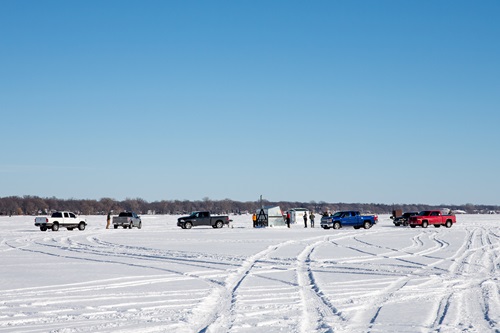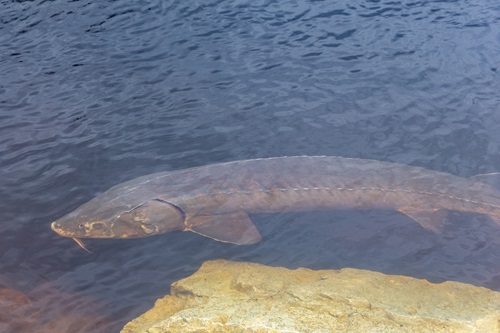
Photo © Fabien Monteil | Dreamstime.com
With lake sturgeon fishing season approaching (opening day is in early February in most states), many anglers will face harvest limitations. But at least they’ll still be allowed to get out there and do their thing.
Last year, the U.S. Fish and Wildlife Service considered putting sturgeon on the endangered list. But because it is a major gamefish (in much the same way as marlin and sailfish), that plan was met with major blowback from sturgeon fishing enthusiasts and destination leaders in states like Minnesota, where sturgeon can mean big business for tourism officials.
But after conducting a thorough species status assessment, the U.S. Fish and Wildlife Service determined lake sturgeon do not require listing under the Endangered Species Act, federal officials declared last April. They noted that ongoing management efforts, such as fish stocking, contributed to the conservation and resiliency of the species.
The announcement “shows the power of collaborative conservation and the impact it can have for species like the lake sturgeon,” said Will Meeks, the service’s Midwest regional director. “The fact that we’re seeing more and more lake sturgeon populations spawning in their historical habitat is a clear sign that restoration efforts are progressing. This success is credited to many partners including states, Tribes, local organizations and others across the country coming together to conserve this species.”

Sturgeons have a prehistoric appearance because of their large size, shark-like tails and bony plate-armored covering. In fact, the fish has sometimes been referred to as “a living dinosaur.” With origins dating back at least 150 million years, the lake sturgeon is one of the largest freshwater fish in North America, occupying rivers and lakes across the eastern and central United States and Canada, and having the ability to grow to about 7 feet in length and weigh 200 to 300 pounds, and live to 150 years of age. Lake sturgeons are prized not only for their size and tremendous fight when hooked but for their meat and eggs, which are used to make caviar.
The most widespread ongoing conservation action considered in the U.S. Fish & Wildlife Service’s assessment was the stocking of captive-reared lake sturgeon. Stocking programs have led to increases in adult lake sturgeon and spawning behaviors, officials said. They added that such successful programs bolstered existing populations and returned lake sturgeon to areas where they had disappeared. Other successful conservation measures include restoring habitat connectivity through dam removal, fish passages and habitat restoration.
These efforts have led to sturgeon showing up in places they haven’t been seen for decades, like Maine — even though they are one of that state’s native fish.
“One of the first indications that we had that they were back in the Downeast region was reports from clam diggers who were seeing these strange marks in the mud,” Dwayne Shaw, executive director of the Downeast Salmon Federation, told WABI.TV earlier this month, noting that sturgeon drag their large tail across the mud to create lines and then use their snout to dig in the muck, leaving behind noticeable holes.
“One thing we know about sturgeon is that they like to come back to the river where they were spawned,” added Lynn Lankshear, sturgeon recovery director for NOAA Fisheries. That return means that sturgeon could be eating invasive green crabs, Shaw speculated.
In Michigan, the Black Lake sturgeon harvest in Cheboygan County is the state’s shortest fishing season. With a harvest limit of six lake sturgeons, the season will close when either the sixth fish is harvested or five fish are harvested at the end of any fishing day. There is no minimum size requirement. In 2023, the season lasted 65 minutes — a marathon compared to the 36-minute season in 2022. Last year’s season was canceled due to risky ice conditions on the lake.
Thin ice upended much of the 2024 sturgeon fishing season in Oshkosh, Wisconsin, too. But with local ice 10 inches thick as of early January (strong enough to support small vehicles), anticipation is high for this year’s harvest, according to NBC26.com. Last year, the ice only was about five inches thick.

“I’m extremely excited; it should be a heck of a season, and I mean, everybody’s excited, it’s not just me,” said Brett Walser, who owns the year-round fishing trips company Eyes to the Sky Guide Service in nearby Fond du Lac. “This year I would think we should do very well considering we haven’t taken as many fish out of the lake these last few years.”
He added that sturgeon season is a community celebration, with one local bar and grill hosting an opening weekend concert series to raise money to help children with special needs give sturgeon spearing a try.
Those kinds of local initiatives, combined with the U.S. Fish and Wildlife Service’s collaborative conservation efforts, bode well for the future of sturgeon fishing. If only the ice cooperates.

